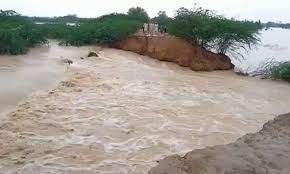As the monsoon season approaches in Pakistan, there is a looming threat of excessive rainfall, particularly in regions prone to hill torrents. If the monsoon rains exceed expectations, the impact could be devastating. Torrential downpours may lead to severe flooding, overwhelming local infrastructure, and displacing communities.
The already vulnerable districts in Punjab, along with parts of Balochistan and Khyber Pakhtunkhwa, could face catastrophic damage to homes, roads, and agricultural lands. Waterlogged fields would destroy crops, leading to food insecurity, while contaminated water supplies could pose serious health risks. The monsoon season underscores the urgent need for effective flood management strategies to mitigate the potential for widespread disaster in these high-risk areas.
Hill torrents are a natural occurrence in hilly and mountainous regions, causing rapid and destructive water flows during heavy rainfall or flash floods. These torrents are primarily triggered by heavy rain, deforestation, land degradation, soil erosion, and poor water management and infrastructure. The damage caused by hill torrents is extensive and multifaceted. They can destroy infrastructure such as roads, bridges, and buildings, posing a significant threat to human and animal life and causing fatalities and injuries. Communities often face displacement and severe disruptions in their daily lives. Agricultural lands and livestock can be severely damaged, leading to food insecurity. Additionally, water sources can become contaminated, posing health risks to the affected populations.
Certain regions in Pakistan are especially susceptible to the destructive effects of hill torrents. Dera Ghazi Khan and Rajanpur districts in Punjab frequently experience flooding and erosion caused by torrents descending from the Sulaiman Range. Additionally, the Koh-e-Suleiman Range, which spans parts of Balochistan and Khyber Pakhtunkhwa, is a significant source of such torrents. Dera Ismail Khan District in Khyber Pakhtunkhwa and the rugged terrains of South Waziristan are particularly vulnerable. In eastern Balochistan, areas like Zhob and Loralai face recurring threats from torrents in the Toba Kakar and Sulaiman ranges. These regions suffer significant damage to infrastructure, agriculture, and communities, especially during the monsoon season. This underscores the critical need for effective watershed management and soil conservation practices.
In 2022, heavy rains and resulting hill torrents from the Suleman Mountain Range caused devastating floods in districts such as Dera Ghazi Khan and Rajanpur. These floods affected over 100,000 people, destroyed nearly 4,000 homes, and submerged over 200,000 acres of agricultural land. The floods destroyed crops and disrupted transportation and communication infrastructure, resulting in a long-lasting economic and social impact on the communities.
To mitigate the impact of hill torrents, communities can adopt several measures. Planting trees and restoring forests can significantly reduce soil erosion. Implementing watershed management and soil conservation practices helps maintain soil stability and water retention. Building flood-resistant infrastructure and protective structures can minimize physical damage during torrents.
Developing early warning systems and emergency response plans ensures timely alerts and coordinated actions during emergencies. Maintaining and cleaning waterways and drainage systems are crucial to prevent blockages and overflow. Educating communities on flood safety and preparedness is essential for proactive risk management. Developing climate-resilient agriculture and livelihood practices can enhance the sustainability and resilience of affected communities.
Several activities can be undertaken to raise community awareness and mitigate the impact of hill torrents in Pakistan. Organizing community workshops and seminars can educate people on the risks and prevention measures associated with hill torrents. Door-to-door campaigns can distribute pamphlets, brochures, and other awareness materials.
Collaborating with local mosques and community centres can help disseminate information and warnings effectively. Engaging with local schools to incorporate hill torrent education into the curriculum ensures that young people are informed and prepared. Community clean-up drives can clear waterways and drainage systems, reducing the risk of blockages and flooding.
Establishing early warning systems and emergency response plans with community involvement is essential to ensure everyone is prepared and can respond effectively. Promoting tree plantation and reforestation efforts helps reduce soil erosion. Encouraging community-led initiatives for flood-resistant infrastructure and protective structures can enhance local resilience.
The government plays a vital role in supporting communities before, during, and after hill torrent events. Infrastructure development investments, such as flood-resistant buildings, bridges, and roads, can significantly reduce damage. Enhancing water management systems, including creating reservoirs and dams, can control water flow. Implementing robust monitoring systems and utilizing technology for real-time data collection can improve early warning systems. Post-disaster recovery plans should include financial aid, psychological and social support services, and community resources to adapt to climate change.
During a hill torrent or flash flooding, communities should take several steps to ensure their safety and well-being. These include staying informed, evacuating immediately, avoiding travel and floodwaters, protecting belongings, staying connected with family members, following instructions from local authorities, and supporting each other. Documenting damage, cooperating with authorities, and participating in community efforts for recovery are also essential.
By prioritizing sustainable development and proactive disaster management strategies, the government can play a vital role in mitigating the impacts of hill torrents and fostering long-term community resilience..
The author is a communications professional with extensive experience in the government, development, and United Nations sectors. He currently works as a communications specialist at the International Water Management Institute (IWMI) in Pakistan.
Disclaimer: The views and opinions expressed in the article belong solely to the author and not necessarily to the author’s employer, organization, or other group or individual.









